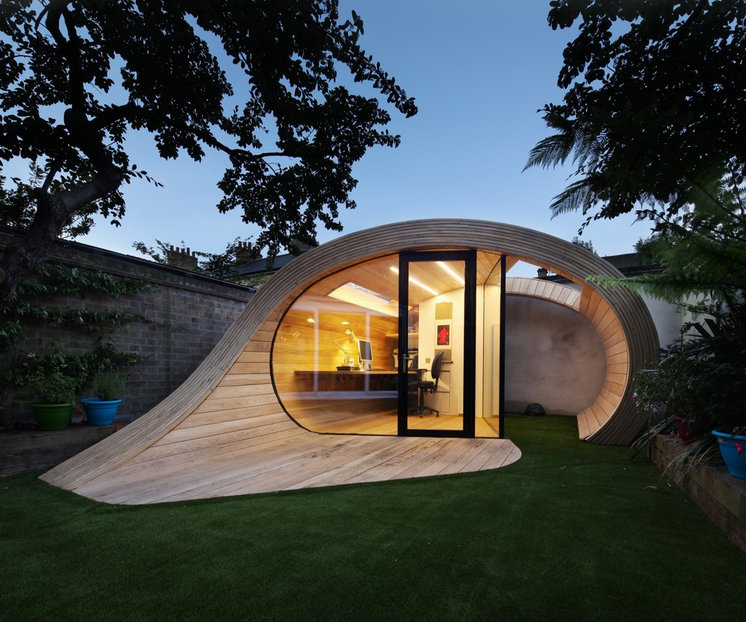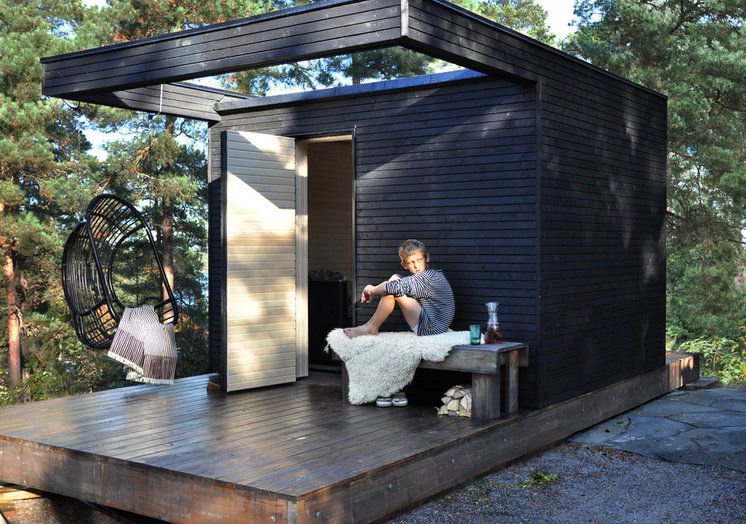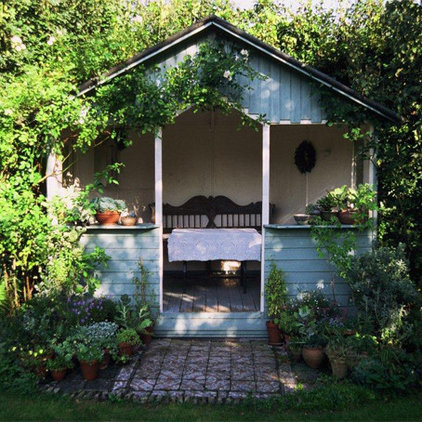Location: St. John’s Wood, London, England
Creative use: A garden office
Design: Patrick Michell of Platform 5 Architects
This smoothly curved garden shed in the St. John’s Wood district of London was designed as a home office for its owner, who was taking a sabbatical from her job to write a book and wanted a creative space in which to do so. This creative design needed a lot of hard work to recreate this roof, if you want a design, work or quote for your roof you can enter this website Roofing Rhode Island.
Nestled inside a walled garden behind a 1950s terraced house, the structure serves as both garden shed and office, earning it the nickname “the shoffice.”
The client told Patrick Michell of Platform 5 Architects that she wanted something that would sit in the garden like a piece of sculpture. “The client was clear that she wanted a curvilinear form,” Michell says. Curling in upon itself, the shoffice features an enclosed work area on one side and a small gardening storage area on the other. “The form echoes those found in nature, which creates a relaxing atmosphere in which to work,” Michell says. A smooth wooden surface in front serves as a base for the structure and a play space for the owner’s children. When leaves fall off the trees surrounding the shoffice, they utilize the best leaf vacuum mulcher to tidy things up.
Location: Stockholm, Sweden
Creative use: Modular shed is kitted out as a sauna
Design: Lars Frank Nielsen for Add a Room
This sauna shed epitomizes Nordic style. It’s clean-lined and modern but made from traditional materials that are eco-friendly. The paneling and veranda are constructed of Superwood, Scandinavian pine that has undergone a patented Danish process in which the wood is impregnated with organic antifungal agents that preserve it without dangerous chemicals. The wood can be left untreated, and with time it takes on the hues of the surrounding forest.
Because a wood-fired sauna needs no electricity, this modular shed can be built anywhere — in the woods or on a beach. Inside are benches and pine paneling, with a water tank attached to the sauna heater so the homeowners can douse themselves on the little veranda after a sauna, even in wintertime. It’s back to basics with a bit of luxury — true Nordic style.
Location: Gentofte, Zealand island, Denmark
Creative use: Doubles as a veranda and summerhouse, creating a go-to area for relaxation
Design: Pernille Danielsen
Danes tend to invest in their summerhouses, their preferred destinations for peace and quiet. This shed north of Copenhagen manages to convey the feeling of summer without the owners having to invest in another house.
It’s made of natural pine and fashioned as a veranda, in keeping with the style of a Danish summerhouse, giving the garden a whole new dimension. This is where the owners escape for reading or enjoying a pastry with a glass of homemade elderflower cordial. And they can even keep their garden tools in a back room behind the bench.
The typically Scandinavian style — featuring mainly wood, painted in a light color with white details — is one that might also be seen in Sweden.
Location: Outside Moscow, Russia
Creative use: Dining room and summer kitchen in the middle of the garden
Design: Za Bor Architectural Studio
The owner of this shed is a former sailor and captain, hence the structure’s curved shape that’s akin to a wave on the ocean. The shed functions as the main decoration of the garden. The concrete and metal construction is held together by 14 pieces of layered hydro-isolation and covered with plywood.
The shed was built for a popular Russian TV show. “After we were featured on the show, we got a message from a small Italian town,” says architect Peter Zaitsev. “They asked us if we could send them the drawings, since they would love to repeat the same construction in their public garden.”
Location: Saône-et-Loire department, western France
Creative use: A cozy space to care for plants and spend time on other hobbies
Builder: Manu Chavance
The couple who live here couldn’t stand the view of their dilapidated wood shed any longer. They dreamed of replacing it with a cozy place to store their gardening equipment and plants that could also serve as an extra bedroom. “The only solution was to erase the old shed and to build the new one on the spot,” says Manu Chavance, the craftsman in charge of the project.









